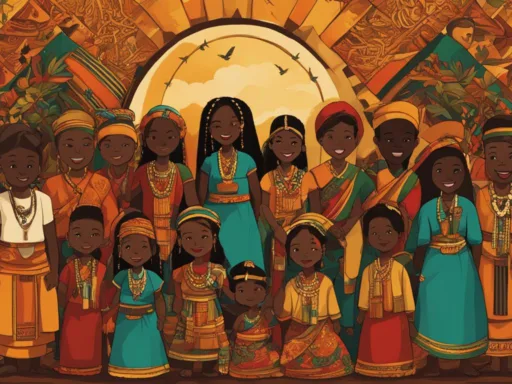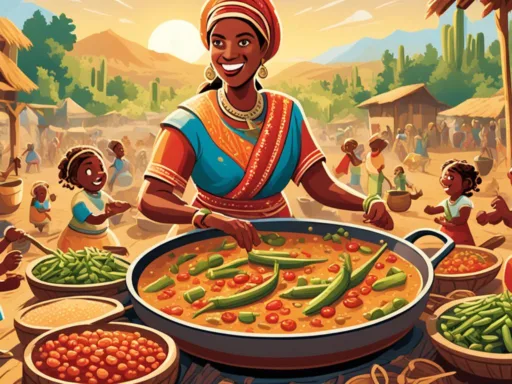Boasting a fluent English-speaking population of 23.8%, Sri Lanka’s linguistic diversity transcends beyond its spoken words to reflect a deep-seated cultural significance that shapes its very essence. The South Asian island nation is a kaleidoscope of languages, with linguistic marvels stretching from the bustling streets of Colombo to the tranquil shores of Jaffna. In this vibrant constellation, the languages spoken in Sri Lanka emerge as powerful symbols of identity, unity, and history. The Sinhalese majority and the Tamil minority work in tandem with various other language speakers, painting a multifaceted linguistic portrait rich with Sri Lankan dialects and accents.
The dance of dialects and accents across the Pearl of the Indian Ocean is not just a matter of communication – it’s a living, breathing testimony to the island’s storied past and its cultural tapestry. With Sinhala and Tamil designated as official languages, the societal interplay of indigenous tones, and the echoes of colonial languages, Sri Lanka serves as a compelling stage for exploring linguistic diversity. From the shores where merchant ships once harbored to the classrooms of the youngest learners, the enduring echo of every spoken word continues to contribute to the dynamic narrative of this enchanting land.
Key Takeaways
- Two official languages, Sinhala and Tamil, anchor the linguistic identity of Sri Lanka.
- Linguistic diversity in Sri Lanka is a testament to the island’s rich cultural legacy.
- English serves as a vital link language, underscoring its importance in commerce and education.
- Sri Lankan dialects showcase the heterogeneity of speech within the same language family.
- The language landscape of Sri Lanka includes indigenous and creole languages reflecting its complex history.
- Languages spoken in Sri Lanka embody both the everyday and the ceremonial of Sri Lankan life.
- Cultural significance is woven into the fabric of Sri Lanka’s linguistic tapestry.
Understanding Sri Lanka’s Linguistic Landscape
The linguistic diversity of Sri Lanka is as vibrant and complex as its history. Sinhala and Tamil, the official languages, are a testament to the island’s deep-seated cultural roots. Alongside these, English plays a notable, albeit unofficial, role symbolizing the modern aspirations and global connectivity of Sri Lanka. Together, these languages paint a picture of a society deeply entrenched in both its local customs and global tides. The intricate mosaic of ethnic languages in Sri Lanka contributes to a rich linguistic tapestry, where each dialect and language carries the weight of its own story.
Here’s a glimpse of how these languages intertwine within the Sri Lankan society:
- The Sinhala language, primarily used by the Sinhalese, encapsulates the essence of the island’s largest ethnic group.
- Tamil, important to both Sri Lankan Tamils and the Moors, is vibrant with its literary tradition and classical heritage.
- English, though not official, serves as a crucial lingua franca, linking Sri Lanka to global commerce and culture.
One can see the influence of past colonial reigns and longstanding trade relationships through the lens of linguistics in Sri Lanka. Portuguese, Dutch, and British legacies live on in the language, with loanwords and linguistic structures serving as remnants of history’s tide.
The intersection of native traditions and the nuances brought by foreign influence gives rise to a unique vernacular fabric that is both intricate and colourful, much like the country’s famed textiles.
Below is a table outlining the major languages of Sri Lanka and their respective speaker populations:
| Language | Speaker Population | Official Status | Primary Ethnic Group(s) |
|---|---|---|---|
| Sinhala | Approx. 16 million | Yes | Sinhalese |
| Tamil | Approx. 5 million | Yes | Sri Lankan Tamils, Indian Tamils, Moors |
| English | Widely spoken, particularly in urban centres | No (Link Language) | Ethnically diverse (secondary language for many) |
The confluence of these languages embodies the cultural and ethnic quilt of the nation, making the language diversity in Sri Lanka not just a point of scholarly interest but a cornerstone of the country’s identity.
Languages Spoken Sri Lanka: The Tapestry of Dialects
The linguistic fabric of Sri Lanka is rich and diverse, featuring a unique blend of spoken vernaculars that have evolved over time. The intricacies of official languages Sri Lanka such as Sinhala and Tamil provide a fascinating study into the nation’s history and cultural dynamics.
Indo-Aryan and Dravidian Influences
At the core of Sri Lanka’s linguistic mosaic are its two official languages, Sinhala and Tamil. Sinhala, an Indo-Aryan language, has woven a tapestry that resonates with the vibrancy of its Pali roots. Tamil, drawing from the rich Dravidian languages family, echoes the voices of ancient settlers from southern India. Both languages serve not only as modes of everyday communication but also as repositories of the island’s collective memory and identity.
These languages, while distinct, share spaces in the everyday lives of Sri Lankans, with each contributing to the linguistic diversity as regional languages Sri Lanka. The existence of various Sri Lankan dialects within these languages further highlights the nuanced linguistic landscape of the country.
Colonial and Foreign Language Impact
The colonial history of Sri Lanka has left indelible marks on its language use, with Sinhala incorporating numerous Portuguese, Dutch, and English loanwords into its vocabulary. This mélange showcases the deep impact of colonial and foreign presences on languages spoken in Sri Lanka. The adaptive nature of language in this regard is a powerful testament to the resilience and malleability of cultural expression in the face of external influences.

| Language Family | Main Languages | Influences | Loanwords Examples |
|---|---|---|---|
| Indo-Aryan | Sinhala | Pali, Sanskrit | Mahaththaya (from Pali “Mahattha”), Devi (from Sanskrit “Devi”) |
| Dravidian | Tamil | Ancient Tamil settlers | Ilankai (from “Sri Lanka”), Kaapi (“Coffee”) |
| Colonial Legacies | Sinhala, Tamil | Portuguese, Dutch, English | Meja (from Portuguese “Mesa”), Kaar (from Dutch “Kar”), Bankuwa (from English “Bank”) |
In summary, the linguistic landscape of Sri Lanka is an emblematic feature of the island that captures the essence of its past and the evolving nature of its socio-cultural identity. A scrutiny into the official languages Sri Lanka is as much a linguistic journey as it is a voyage into the heart of the nation’s soul.
The Official Languages of Sri Lanka: Sinhala and Tamil

As the official languages of Sri Lanka, both the Sinhala language and the Tamil language play landmark roles in the country’s cultural and communicative strata. The Sinhalese people, who form the majority of the population, communicate primarily in Sinhala, a language steeped in rich literary tradition and linguistic pride. An estimated 16 million people, roughly three-quarters of Sri Lanka’s population, speak Sinhala, which is also comprehensible to a wide margin, approximately 87%, of Sri Lankans.
On the other side of the linguistic spectrum, the Tamil speakers enrich the cultural diversity of the island. Tamil is crucial to the Tamil-speaking communities in Sri Lanka, which include native Sri Lankan Tamils, as well as Indian Tamils who have made the island their home. This language is more than a means of communication—it is a badge of cultural identity for around 5 million speakers in Sri Lanka. Together, these tongues foster a landscape where language is both a means of everyday exchange and a vessel of heritage.
- Sinhala Language: Dominant language mainly used by the Sinhalese people
- Tamil Language: An integral part of Sri Lankan Tamils and Indian Tamils in Sri Lanka
- Cultural Identity: Both languages serve as symbols of heritage and identity
- Communication: Essential to dialogue and social interactivity across the country
The interplay between the official languages of Sri Lanka reflects not only a pragmatic approach to communication but also illustrates the nation’s commitment to preserving the linguistic nuances of its two primary ethno-linguistic groups. As the world becomes increasingly interconnected, understanding the dynamic roles Sinhala and Tamil play within Sri Lanka’s borders is paramount to appreciating the nation’s unique sociolinguistic landscape.
The Role of English in Sri Lankan Communication
While Sinhala and Tamil are the official languages of Sri Lanka, English occupies a crucial position in the country’s linguistic ecosystem. It bridges the communication gap in multilingual settings, serving significantly in the spheres of business and administration. The prevalence of English in Sri Lanka is not just a remnant of the colonial past, but also a reflection of the island’s progressive efforts towards modernity and globalization. The proficiency in English varies across the population but is notably higher in urban and touristic areas.
English in Business and Administration
In Sri Lanka, English is the lingua franca for many corporate environments and government entities. Language education has been pivotal in equipping the workforce with the necessary skills to engage in international trade and diplomacy. This has also turned English into a competitive asset for Sri Lankans, allowing them to participate actively in global markets.
English Education in Sri Lanka
The strong focus on language education is evident from the early integration of English into the schooling system. English as a second language is taught from primary levels, aiming to create fluent speakers by the time students culminate their secondary education. Beyond fluency, the variant of Sri Lankan English has evolved to incorporate elements from local dialects, making it a unique form of communication reflecting the country’s identity.
Besides formal education, there are numerous initiatives aimed at enhancing English proficiency among minority language speakers in Sri Lanka, ensuring that everyone has the opportunity to develop this critical skill. The table below reflects the integration of English language education in various stages of learning:
| School Level | Introduction of English | Proficiency Goals |
|---|---|---|
| Primary Education | Begins as a second language subject | Basic communication skills |
| Secondary Education | Continued and strengthened teaching | Intermediate to advanced fluency |
| Higher Education | Utilized in various academic disciplines | Professional and academic proficiency |
The ongoing dedication to English instruction underscores its significance in preparing students for a rewarding professional future, whether within Sri Lanka or on an international stage. As English continues to be the medium in which global discourse takes place, its place in Sri Lankan society grows ever more entrenched; not just as a language of the past, or even of the present, but as a gateway to countless possibilities in the future.
Regional Languages: Reflecting Sri Lanka’s Ethnic Diversity
Delving into the heart of Sri Lanka’s cultural landscape, one encounters an enriching tapestry of regional languages that signify the country’s profound ethnic diversity. These languages not only provide a voice to the various ethnic communities but also serve as a vibrant emblem of language representation within the nation’s multifarious society.
Among the kaleidoscope of languages, the Sri Lankan Moors have preserved their unique linguistic traditions in the form of the Sri Lankan Moor dialect, which imbues the fabric of regional languages with a distinctive cultural thread. This particular community, with its Arab-influenced heritage, showcases the island’s longstanding history as a melting pot of civilizations.

The indigenous Veddah language adds another rich hue to this mosaic. As the conversational thread of Sri Lanka’s first inhabitants, it offers a unique glimpse into the Island’s ancestral roots. The Sri Lankan Malay language, on the other hand, is a testament to the enduring legacy of Southeast Asian maritime traders who left their linguistic imprint on the island.
Here’s a snapshot of how regional languages manifest Sri Lanka’s ethnic tapestry:
- Sinhala – Spoken primarily in the Central, Western, Southern, and North-Western provinces.
- Tamil – Predominantly used in the Northern and Eastern provinces.
- Indigenous Veddah – Limited to some regions where Veddah communities reside.
- Sri Lankan Malay – Spoken by the Malay minority, notably in urban areas with historic trade links.
As we traverse the lush landscapes of this island nation, we uncover the voice of its people, resonating through the myriad of regional languages that stitch together Sri Lanka’s ethnically diverse society. It is a linguistic voyage that celebrates every nuance and narrative woven into Sri Lanka’s historical fabric.
Minority Languages and Their Histories in Sri Lanka
The rich tapestry of Sri Lanka’s linguistic heritage is significantly augmented by its minority languages. Each language enshrines a particular facet of the nation’s multicultural identity, narrating tales of historical interactions and preservations of ancient customs.
The Veddah Language: An Indigenous Tongue
Among the minority languages, the Veddah language stands out as a poignant reminder of Sri Lanka’s earliest inhabitants. Spoken by the Veddah people, indigenous Sri Lankans, this language connects present-day society with echoes of a storied past, wherein languages function as cultural bearers over generations.
Creole Influences: Portuguese and Malay Legacies
The Sri Lankan Portuguese Creole and Sri Lankan Malay illustrate the country’s historical tapestry woven by colonial and trading episodes. These Creoles are emblematic of the linguistic adaptations that arose from significant socio-cultural exchanges with Portuguese colonial power and Malay influences throughout history.
| Language | Origin | Community | Status |
|---|---|---|---|
| Veddah | Indigenous | Veddah People | Endangered |
| Sri Lankan Portuguese Creole | Portuguese Colonial | Portuguese Descent | Moribund |
| Sri Lankan Malay | Malay Influence | Malay Descent | Vital |
In reviving and conserving these minority languages of Sri Lanka, linguists and cultural historians encounter a profound connection to the island’s diverse ethnic legacies. The ongoing interest in these languages reaffirms the value placed on preserving a linguistic diversity that remains crucial to the nation’s identity.
Multilingual Signage: A Glimpse into Societal Bilingualism
Stepping through the bustling streets of Sri Lanka, one is enveloped by an impressive display of multilingual signage. These signs, which seamlessly integrate Sinhala, Tamil, and English, serve not only as practical guides but also as vibrant emblems of societal multilingualism. Each brightly colored placard or official notice tells a story of a society deeply connected to bilingual communication.
The commitment to accommodating a linguistically diverse population is paramount, and the inclusion of all three languages on public signs embodies this dedication. In government buildings, transport hubs, and tourist spots, multilingual displays are a thoughtful provision for natives and visitors alike, fostering a sense of inclusivity and comprehension regardless of one’s linguistic prowess.
- Street Signs: Navigating with ease in Sinhala, Tamil, and English
- Educational Institutions: Bilingual boards that welcome future generations
- Public Transportation: Announcements and schedules for an interconnected society
- Emergency Services: Ensuring accessibility and safety for all
Moreover, this approach mirrors the national ethos of unity through diversity, setting a standard for societal multilingualism that many countries aspire to. As one admires this confluence of language and culture, it’s evident that Sri Lanka’s multilingual signage is not merely about directionality; it’s a testament to the harmonious coexistence of languages thriving in the heart of Asia.
Language in Sri Lankan Education: From Primary to Higher Studies
Sri Lanka’s commitment to language diversity is personified within its education system, fostering a rich blend of language learning and usage. The educational linguistics of the region encourage a deep-rooted multilingualism, crafting a resilient framework for the nation’s youth. By investing in a language curriculum that is both inclusive and diverse, the country sets a foundation not only for educational success but also for the collective goal of national unity through language.
Curriculum Languages
The diversity of languages taught within Sri Lankan schools highlights the dedication to both cultural heritage and global interconnectedness. Sinhala and Tamil are central to the language curriculum, ensuring that students are well-versed in the nation’s official languages. Alongside these, English is introduced to bolster international competence and aid in career prospects, reinforcing its position as a valuable tool in the broader global community.
From the outset of their schooling, children are introduced to the intricacies of their mother tongue as well as English, laying the groundwork for a multidimensional linguistic skillset. The prominence of these linguistic pathways in primary education paves the way for more specialized language studies in secondary schools and beyond.
Language Instruction for National Unity
Aiming to bridge cultural divides, language instruction in Sri Lanka is more than a pedagogical pursuit—it’s a unifying force. Teachers are the catalysts, encouraging students to embrace linguistic diversity as a means to foster empathy and intercultural dialogue. In this environment, understanding transcends verbal communication; it becomes the thread that weaves through the fabric of Sri Lankan society.
| Language | Role in Curriculum | Impact on Unity |
|---|---|---|
| Sinhala | Primary instruction medium for Sinhalese students | Promotes cultural identity and national heritage |
| Tamil | Primary instruction medium for Tamil students | Encourages inclusivity and minority representation |
| English | Secondary language; bridge for global engagement | Facilitates international communication and connectivity |
In summary, the language education system in Sri Lanka encapsulates the powerful interplay between learning and societal harmony. By upholding a multifaceted language curriculum, the nation endorses a future where diversity is celebrated, and unity is a shared language.
Conclusion
Delving into the intricate fabric that is Sri Lanka’s linguistic milieu, one can’t help but be fascinated by the cultural richness that language imparts to the island nation. Within its boundaries, languages spoken in Sri Lanka bridge communities and foster linguistic harmony, setting a global precedent for multicultural coexistence. The two official tongues, Sinhala and Tamil, provide the bedrock upon which communication and cultural identities are nurtured, creating a vibrant and inclusive social mosaic.
English, though not official, plays a pivotal role and is distinctly woven into the fabric of Sri Lankan daily life, serving as an indispensable link language in business and education. This lingual trinity is augmented by a constellation of minority languages, each with its unique narrative and historical significance. These idioms are the threads that decorate Sri Lanka’s cultural tapestry, adding depth and character to the nation’s collective heritage.
It is therefore evident that the language diversity intrinsic to Sri Lanka’s heritage is more than just a means of communication. It is a testament to the country’s ongoing commitment to celebrating its cultural richness. From the bustling streets adorned with multilingual signage to the halls of academia where language education flourishes, Sri Lanka exemplifies a genuine reverence for its linguistic landscape. This respect for the spoken and written word is not only a pillar of Sri Lankan society but also a beacon of unity and understanding in an increasingly diverse world.
FAQ
What are the official languages spoken in Sri Lanka?
The official languages in Sri Lanka are Sinhala and Tamil, with each language serving as a key symbol of identity for their respective ethnic groups. Sinhala is primarily spoken by the Sinhalese people, while Tamil is spoken by the Sri Lankan Tamils and the Indian Tamils of Sri Lanka.
How does the linguistic diversity of Sri Lanka reflect its cultural significance?
Linguistic diversity in Sri Lanka is a mirror of its cultural richness. The island is home to various languages and dialects, each with its unique heritage and historical context, emphasizing the various ethnicities and cultural influences that have shaped the country.
Are there different dialects within the Sinhala and Tamil languages spoken in Sri Lanka?
Yes, there are distinct dialects within the Sinhala and Tamil languages across Sri Lanka. Differences in pronunciation, vocabulary, and grammar can be found depending on geographic regions and local influences.
What is the linguistic landscape of Sri Lanka like?
Sri Lanka’s linguistic landscape is composed of a variety of languages that showcase the country’s ethnic and cultural diversity. Alongside the official languages Sinhala and Tamil, other languages are spoken, like English, which is used as a link language, and minority languages such as the Veddah language and Sri Lankan Portuguese Creole.
How do the Indo-Aryan and Dravidian influences shape the languages spoken in Sri Lanka?
The Sinhala language, belonging to the Indo-Aryan family, and the Tamil language, part of the Dravidian family, have been shaped by ancient cultural exchanges and migrations. These influences have left a mark on the vocabulary, syntax, and pronunciation of local languages, creating a unique linguistic identity for the island.
How have colonial and foreign language impact affected Sri Lankan dialects?
Sri Lanka’s history of colonialism has introduced several loanwords and linguistic structures from Portuguese, Dutch, and English into local languages, especially Sinhala. These foreign languages have also affected the development of creole languages like the Sri Lankan Portuguese Creole, attesting to the country’s rich history of global interactions.
What roles do Sinhala and Tamil play in Sri Lankan society?
Sinhala and Tamil play crucial roles in daily communication, education, and administration in Sri Lanka. They are not only tools for interaction but also carry immense cultural and identity value for the Sinhalese and Tamil communities, respectively.
How prevalent is English in Sri Lanka?
English is widely spoken in Sri Lanka, especially in urban centers and within business and administrative contexts. Approximately 23.8% of Sri Lankans speak English fluently, and it is taught as a second language from the primary levels in educational institutions. Sri Lankan English also serves as evidence of the country’s British colonial history.
What regional languages are spoken in Sri Lanka?
In addition to Sinhala and Tamil, regional languages such as the Veddah language and Sri Lankan Malay reflect the diverse ethnic groups in Sri Lanka. These languages are part of the unique cultural identities of communities such as the indigenous Veddah people and the descendants of Malay immigrants.
How are minority languages preserved in Sri Lanka?
Minority languages in Sri Lanka are preserved through community practices, oral traditions, and in some cases, literature. These languages, such as the Veddah language and creoles influenced by Portuguese and Malay, represent the historical layers of the island nation’s past interactions and are respected aspects of its diverse cultural heritage.
What does multilingual signage in Sri Lanka indicate?
Multilingual signage, often in Sinhala, Tamil, and English, reflects societal bilingualism and the government’s endeavor to accommodate a linguistically diverse population. This inclusivity aims to facilitate communication and navigation for all citizens and visitors.
How is language diversity promoted in Sri Lankan education?
Language diversity in Sri Lanka is promoted through an education system that emphasizes trilingual proficiency. Sinhala and Tamil are used as mediums of instruction, and English is taught as a compulsory second language. The goal is to foster mutual understanding and national unity while maintaining each language’s cultural importance.
Why is language education important for national unity in Sri Lanka?
Language education in Sri Lanka is seen as a cornerstone for national unity as it enables communication and cultural exchange among the various ethnic groups. Through language instruction and a curriculum that prioritizes linguistic diversity, the educational system works toward a cohesive society that respects and understands its varied cultural backgrounds.
How does the multitude of languages spoken contribute to the cultural richness of Sri Lanka?
The multitude of languages spoken in Sri Lanka, including Sinhala, Tamil, English, and various minority languages, contribute to the island’s cultural richness by serving as a living record of its diverse history. These languages are not only methods of communication but also vessels for traditions, literature, arts, and shared human experiences that enliven the country’s heritage.






